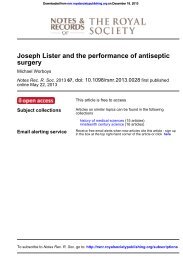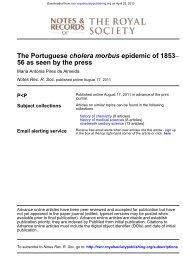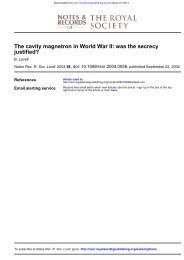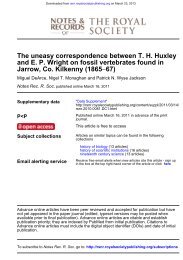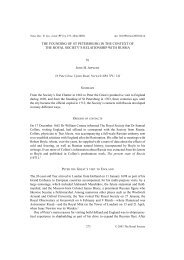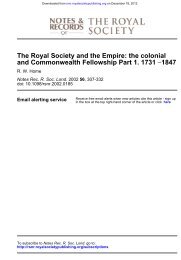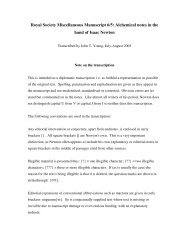an unpublished letter from henry oldenburg to johann heinrich rahn
an unpublished letter from henry oldenburg to johann heinrich rahn
an unpublished letter from henry oldenburg to johann heinrich rahn
You also want an ePaper? Increase the reach of your titles
YUMPU automatically turns print PDFs into web optimized ePapers that Google loves.
Downloaded <strong>from</strong><br />
rsnr.royalsocietypublishing.org on December 6, 2012<br />
264 Noel Malcolm<br />
39 Isaac Barrow, Lectiones geometricae: in quibus (praesertim) generalia curvarum linearum symp<strong>to</strong>mata<br />
declar<strong>an</strong>tur (London, 1670). Lecture 13 (pp. 131–147) gives 13 ‘series’ of equations for<br />
different types of curve. (The copyist’s semicolon here is <strong>an</strong> error; Collins’s draft refers <strong>to</strong> ‘[>a]<br />
lecture about curves proper for solving of Aequations at the end of D r Barrowes Geometricall lectures’<br />
(StAUL, MS 31009, fo. 31 r ).)<br />
40 Michael Dary, Dary’s Miscell<strong>an</strong>ies: Being, for the Most Part, a Brief Collection of Mathematical<br />
Theorems, <strong>from</strong> Divers Authors (London, 1669).<br />
41 See Rahn’s <strong>letter</strong> <strong>to</strong> Haak, above.<br />
42 Carlo An<strong>to</strong>nio M<strong>an</strong>zini, L’occhiale all’occhio, dioptrica practica (Bologna, 1660).<br />
43 Fr<strong>an</strong>cesco Eschinardi, Dialogus opticus, in quo aliquibus quaesitis compendiose respondetur<br />
[with] Centuria problematum opticorum … seu dialogi optici pars altera [<strong>an</strong>d] Centuriae opticae<br />
pars altera, seu dialogi optici pars tertia (Rome, 1666).<br />
44 Gilles Fr<strong>an</strong>çois de Gottignies was a Jesuit scientist <strong>an</strong>d mathematici<strong>an</strong> who had studied under<br />
Grégoire de Saint-Vincent in Antwerp <strong>an</strong>d had become Professor of Mathematics at the Collegio<br />
Rom<strong>an</strong>o. In a <strong>letter</strong> <strong>to</strong> Oldenburg <strong>from</strong> Venice written on 20 J<strong>an</strong>uary 1671, John Doding<strong>to</strong>n had<br />
written that ‘Padre Gottignes hath allmost finished a very Curious Booke concerning the<br />
admirable effects In dioptrica’ (OC vii, p. 405). In his <strong>letter</strong> <strong>to</strong> Collins of November or December<br />
1670 (copied in Collins’s <strong>letter</strong> <strong>to</strong> Gregory of 15 December 1670: Turnbull, op. cit. (note 12), p.<br />
140), the French Jesuit Je<strong>an</strong> Bertet had written that a work by de Gottignies on telescopes was on<br />
sale in Rome. Oldenburg asked Doding<strong>to</strong>n <strong>to</strong> send ‘Gottignies Dioptricks’ (<strong>to</strong>gether with ‘Fabri<br />
in Archimedem’: see below, note 61) on 10 February 1671 (OC vii, p. 447); Doding<strong>to</strong>n wrote on<br />
4 April that he would send both works when he obtained them (ibid., vii, p. 551). But nearly a<br />
year later, on 4 March 1672, Oldenburg wrote <strong>to</strong> de Sluse (on the basis of a draft supplied by<br />
Collins) that ‘We still do not know what has happened in Italy <strong>to</strong> … Gottignies’s dioptrics, l<strong>an</strong>guishing,<br />
it is said, in a printer’s shop in Rome’ (ibid., viii, p. 576; cf. p. 546 for the draft). The<br />
work appears never <strong>to</strong> have been published.<br />
45 Honoré Fabri, Synopsis optica, in qua illa omnia quae ad opticam, dioptricam, ca<strong>to</strong>ptricam pertinent<br />
… breviter quidem, accurate tamen demonstr<strong>an</strong>tur (Lyon, 1667). The lens-design<br />
(invented by the prominent optical instrument-maker Eustachio Divini) is presented in Prop. 46<br />
(pp. 131–138).<br />
46 Père Cherubin d’Orlé<strong>an</strong>s, La Dioptrique oculaire, ou la theorique, la positive, et la mech<strong>an</strong>ique,<br />
de l’oculaire dioptrique en <strong>to</strong>utes ses especes (Paris, 1671).<br />
47 In Collins’s draft this information is given as follows: ‘In Fr<strong>an</strong>ce the large <strong>an</strong>d beautifull<br />
Dioptricks of Pere Cherubin is lately come out, of which Mons r Reignault a learned Math: of<br />
Lyons gives this character: ‘Je admire la belle Impression de la dioptrique du P. Cherubin sa dottrine<br />
est fort bonne. Ie ne auois pas une si gr<strong>an</strong>d Idee q’ Jenay, ce Liure est excellent le public luy<br />
en est gr<strong>an</strong>dement oblige’ [‘I admire the fine edition of Father Cherubin’s Dioptrique; the contents<br />
of his teachings are extremely good. I did not have such a high opinion of it before as I do<br />
now; the book is excellent, <strong>an</strong>d the public is very much obliged <strong>to</strong> him for it’] (StAUL, MS<br />
31009, fo. 31 v ). In <strong>an</strong> earlier <strong>letter</strong> <strong>to</strong> Gregory (6 May 1671), Collins quoted this comment by<br />
Raynaud <strong>an</strong>d said that it was made in ‘a private Letter’ <strong>to</strong> Collins’s Jesuit correspondent, Je<strong>an</strong><br />
Bertet (Turnbull, op. cit. (note 12), p. 186). Fr<strong>an</strong>çois de Regnauld, seigneur du Buisson<br />
(1626–89), was a distinguished amateur mathematici<strong>an</strong>, <strong>an</strong>d a pupil <strong>an</strong>d friend of Honoré Fabri,<br />
resident in Lyon: see J. Pernetti, Recherches pour servir à l’his<strong>to</strong>ire de Lyon, ou les lyonnais<br />
dignes de mémoire, 2 volumes (Lyon, 1757), ii, pp. 122–124.<br />
48 Isaac Barrow, Lectiones XVIII, C<strong>an</strong>tabrigiae in scholis publicis habitae; in quibus opticorum<br />
phaenomen�n genuinae rationes investig<strong>an</strong>tur, ac exponuntur (London, 1669).<br />
49 Erasmus Bartholinus, Experimenta crystalli Isl<strong>an</strong>dici disdiaclastici quibus mira & insolita<br />
refractio detegitur (Copenhagen, 1669).<br />
50 Joh<strong>an</strong>n Heinrich Ott, Cogitationes physico-mech<strong>an</strong>icae de natura visionis (Heidelberg, 1670);<br />
this was the text of a lecture presented at Heidelberg University in December 1669. The author,<br />
who was <strong>from</strong> Schaffhausen <strong>an</strong>d is known <strong>to</strong> have studied medicine in Basel, Montpellier <strong>an</strong>d



